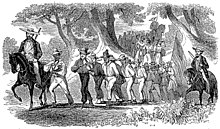|
Coffle
 A coffle, sometimes called a platoon or a drove, was a group of enslaved people chained together and marched from one place to another by owners or slave traders.[1][2][3] These troupes, sometimes called shipping lots before they were moved, ranged in size from a fewer than a dozen to 200 or more enslaved people. HistoryIn the southern United States before the Civil War, slave traders such as Franklin and Armfield arbitraged slave prices by purchasing slaves at low prices in Mid-Atlantic states such as Virginia, and then reselling them at a higher price in deep-south, especially in New Orleans, Louisiana, and in Natchez, Mississippi, at the Forks of the Road Market. Franklin and Armfield established slave pens near Alexandria, Virginia, to hold slaves, and when a sufficient number were gathered, some were transported by ship. Others were handcuffed to long chains in groups of 100 (a coffle) and force marched to the markets of the deep south, where they would be sold as slaves. Their professions were varied as some would be laborers, seamstresses, carpenters and "fancy girls", who would serve as concubines.[4] The trader Austin Woolfolk reportedly wanted to collect nine or more enslaved people in a platoon before he began moving them from place to place.[2] The slave traders rode horses, while the enslaved "women were tied together with a rope about their necks like a halter, while the men wore iron collars, fastened to a chain about a hundred feet long and were also handcuffed."[5] A letter from Georgia written in 1833 described "During this and other days I have passed by many negro traders, who were crossing to Alabama. These negro traders, in order to save expense, usually carry their own provisions, and encamp out at night. Passing many of these encampments early in the morning, when they were just pitching tents, I have observed groups of negroes hand-cuffed, probably to prevent them from running away. The driver told us, that a thousand negroes had gone on his road to Alabama, the present spring."[6] J. K. Paulding, a noted writer, later U.S. Secretary of the Navy, and one of the most articulate and ardent defenders of American slavery, witnessed the following scene in Virginia in 1816, indicating that especially in the early 19th century, coffles might be a dozen or so enslaved individuals escorted by just one trader–overseer:[7]
Sometimes coffles were prepared in advance, sometimes they were assembled or disassembled along the route of a particular trader. According to Plantation Slavery in Georgia (1933), "The daughter of Joseph Tooke, a prominent Houston County planter, recalls the annual visits of the speculator, with his gang of slaves, to their home; the Negroes would camp in a grove near the highway, Tooke would go down, inspect the slaves, and purchase those needed."[8] One memoirist recalled seeing a coffle in Mayslick, Kentucky, a "company of forty or fifty men, chained in the same manner as those mentioned before. There were some five or six wagons loaded with women and children. The foremost man looked to be about seventy years old, and he was singing 'Hark, from the Tomb.' Mrs. Ann Anderson, a white woman who was sitting at the window, could not help crying."[9] See alsoReferences
Sources |